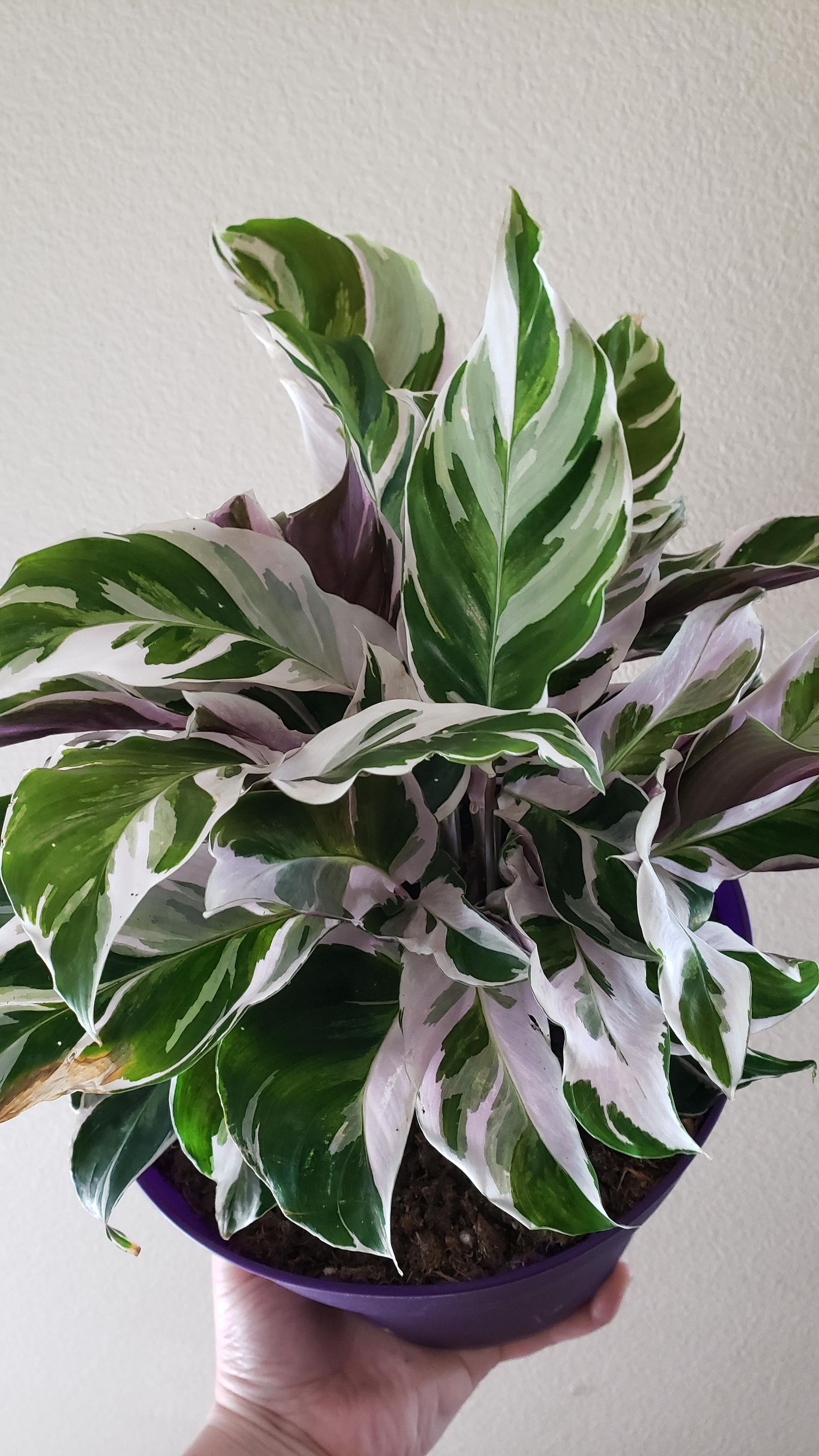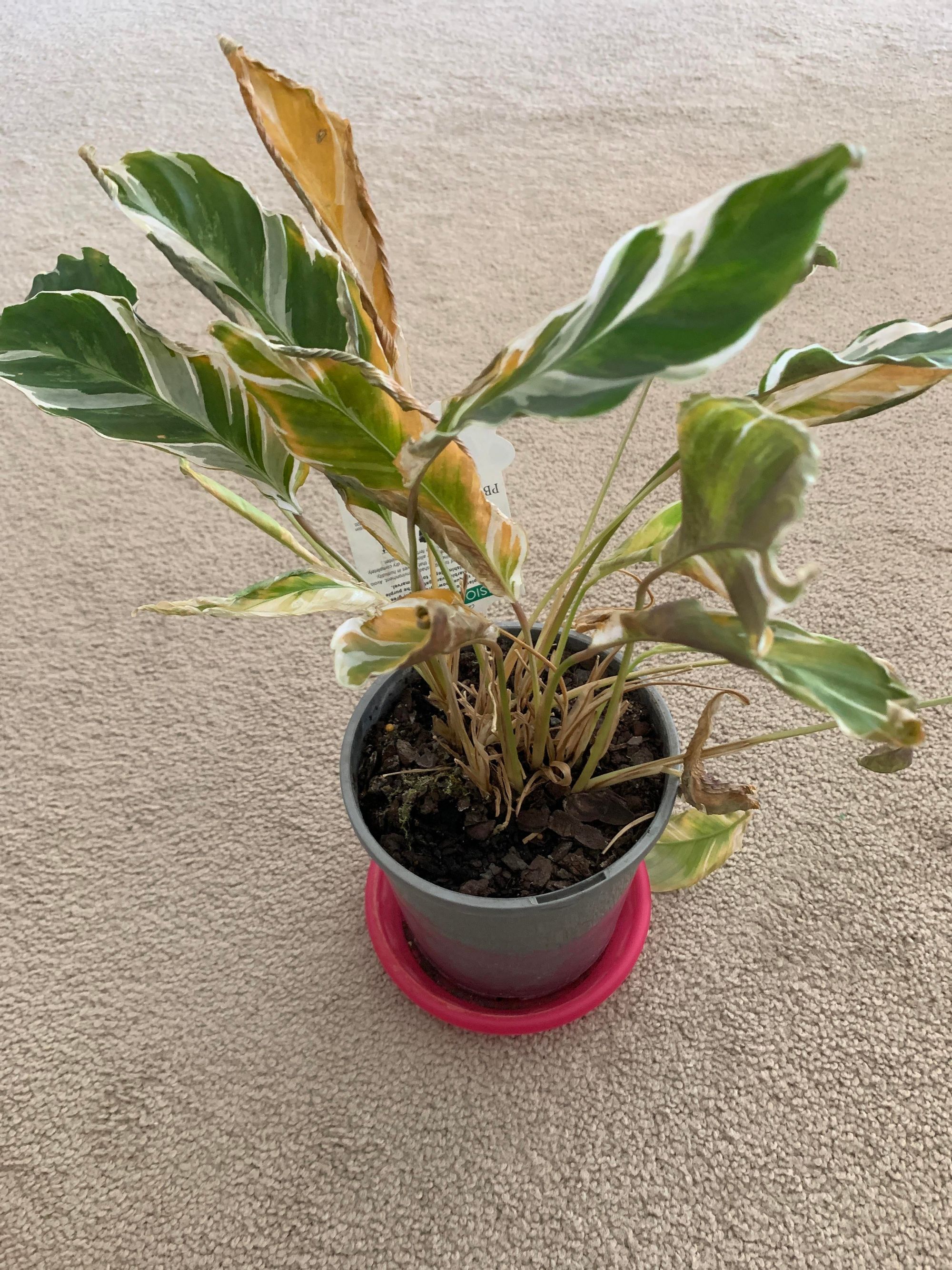7 facts about the Calathea White Fusion (Calathea Lietzei)
The Calathea White Fusion is a rarity in the Calathea family of plants. It has elongated oval, patterned leaves and can grow up to 30-40cm high. The upper side shows different shades of green and a strong beautiful white variegation, the underside of the leaves is also pale pink.

Updated May 2022
The Calathea White Fusion is a rarity in the Calathea family of plants. It has elongated oval, patterned leaves and can grow up to 30-40cm high. The upper side shows different shades of green and a strong beautiful white variegation, the underside of the leaves is also pale pink.
Generally, Calathea plants are known for being temperamental and difficult to care for, the Calathea white fusion variety is no different. Many plant owners say the plant has worse diva attitudes than Mariah Carey at the height of her career.
If you are a beginner in plant caring, I will advise you to avoid this diva plant for now. It can be super hard to keep alive and it will punish you for any little mistake you make with it. Moreover, it is quite difficult to find in the market.
In this guide, we will cover some of the most important facts you need to know about the Calathea white fusion plants and how to care for it.
Calathea white fusion plants are man-made
Whilst Calathea plants can be found in the wild (naturally occurring), you would be surprised to know that the white fusion variety is not naturally occurring.
They were invented in a greenhouse lab in 2007 by the inventor Taiyan Yam in Malaysia. You can check out the patent if you’re curious.
The new species was tested for stabilisation and reproduction in Florida for over 4 years until it was available for purchase in 2013.
Calathea white fusion thrives in high humidity
If you live in a dry area like LA, you should really consider purchasing a household humidifier in the range of $200.
With this, you can set the humidity level to accommodate the Calathea plant. A humidity level of 50% to 60% is recommended. If you have enough space for an indoor greenhouse, you should keep the white fusion plant there and make sure that the humidity never drops below 50%.
If you don’t have an indoor greenhouse, you can use your bathroom with the windows slightly opened. Just make sure that you constantly check up on it, because if it gets too humid the leaves will rot.
I told you she’s a tricky plant to care for…
She only drinks distilled or natural water (really a diva!)
Buy gallons of distilled water from your favourite grocery store, you don’t have to spend more than $10 every month. You can also use rain water because of its natural purity.
Filtered water will do, but it still contains some element of fluoride and the white fusion could still react to this because… diva. You might find that your calathea accepts filtered water, if that’s the case then you shouldn’t have to change anything for now.
However, if you’ve been watering the plant regularly and you can still notice problems with the calathea white fusion - then you need to make a full switch to distilled water and see if that should do the trick.
Keep the white fusion away from bright direct light
Calathea plants generally do not like direct bright light, if they have too much direct light, they will literally shrivel up and die.
This doesn't mean that you should put the plant in full shade. You need to find a partially lit area like behind a light curtain where the plant can receive some indirect light. If you don’t have this type of natural lighting, consider purchasing a grow light bulb on amazon and keep the plant near this source of artificial light.
To Mist or not to Mist your Calathea?
If you are new to plant care, misting just means spraying water from a spray bottle onto the plant instead of watering directly. As you can imagine, misting sprays the water around the plant in tiny blops, reducing the risk of overwatering. It increases the overall humidity around the plant.
You will find different arguments for and against misting. Some people believe that misting increases the humidity around the plant, which is very helpful for Calathea owners who live in dry environments.
Whilst others think misting is just a myth.
All I can say is - there are many owners of the Calathea white fusion plant that praise misting as a lifesaver. So I lean towards misting! Just don’t overmist, that will kill the leaves too.
Calathea White fusion is easily infected
The white fusion becomes more prone to bugs of all kinds when she is stressed (under watered or over watered or low humidity)
Don’t wait until your plant is infected before you treat it - you should create a preventative treatment schedule (once a month is good) where you spray the leaves of your plant with any of the solutions mentioned above and leave it to dry overnight. ;
Calatheas are spider mite magnets! Sometimes they are infected in the plant shop before you even purchase them. It is important to look out for the signs of spider mite infection on your calathea plant. Also, try to avoid putting a new plant with other plants straight away- you never know if it’s infected.
To find out if the plant has been infected with Spider mite, take a look at the back of the leaves and look for signs of any spider web pattern. If you find anything like this, make sure you use a neem oil spray (COLD PRESSED NEEM) and some q-tips to wipe down every leaf every day for a minimum of 10 days.
Some plant growers might find neem oil spray too strong for their Calathea, in this case a safe alternative thing to do is to use a 50/50 Alcohol + Water mixture to wipe down the leaves.
Troubleshooting Calathea White fusion

Your Calathea white fusion leaves are turning brown, yellowish
Calatheas are difficult plants, they struggle to adapt to conditions that are less than ideal. This is why it is important that you make as few mistakes as possible with this plant and always test and observe.
If your calathea white fusion leaves are turning brown, it could be a one of many things like:
- Mineral toxicity from using tap water instead of distilled or rainwater.
- Overfertilisation, they don’t like to be fed too much
- Overwatering or underwatering
- Overexposure to direct sunlight, reduce this by placing the plant behind a light curtain
- Dry soil ; it is very important to constantly check the soil moisture of the calithea
Remember to cut off the brown infected leaves
In a humid environment, those crispy brown yellow leaves could harbour more fungus that will affect the entire plant. So you have to prune away the worst looking leaves to allow the plant to grow fresh ones in its place.
Conclusion:
The calathea white fusion is an indoor plant, so it thrives in warmer temperatures in the range of 18-24 degrees. It does not mean that the plant will automatically shrivel up and die if you leave it outside for a while.
Some plant owners have done this in the past and the leaves didn’t grow as much as they would have done if it were indoors. So if you want to keep the leaves bright, happy and strong then it’s best you keep this plant indoors at the recommended temperature.
My final advice to all plant carers (especially white fusion owners) is to always record, measure, test and observe the effects of any treatment on the plant.
No two plants are the same, and some plants might react differently to the same treatment. It is important to always test and make changes where necessary.